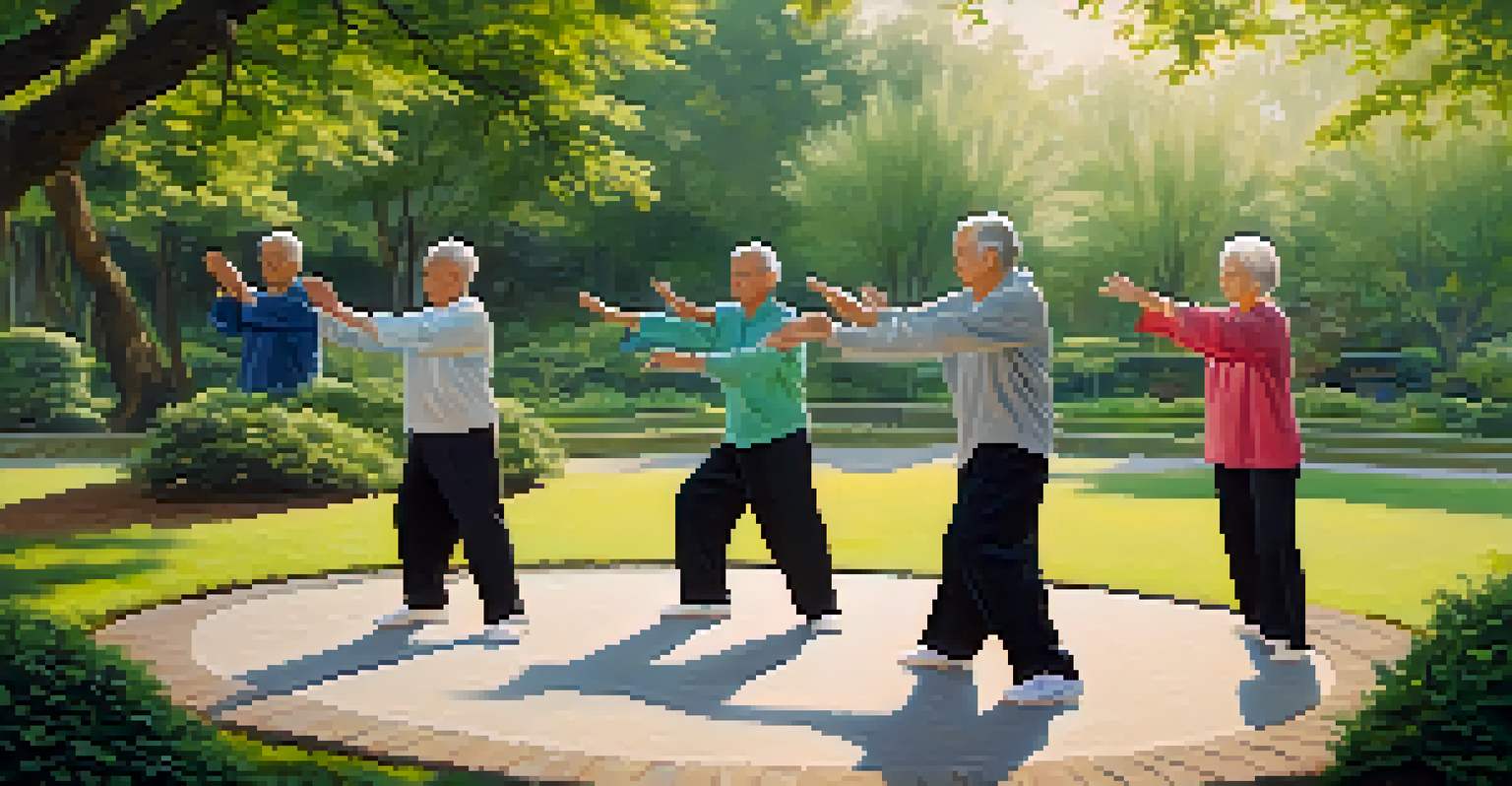Understanding the Importance of Flexibility for Seniors

What Is Flexibility and Why It Matters for Seniors
Flexibility is the range of motion in our joints and muscles, and it plays a crucial role in overall health, especially for seniors. As we age, our bodies naturally become stiffer, making everyday movements more challenging. This decrease in flexibility can lead to a higher risk of injuries and falls, which are significant concerns for older adults.
Flexibility is the key to stability.
Maintaining flexibility helps improve balance and coordination, which are essential for preventing falls. Imagine your body as a rubber band: when it's stretched and flexible, it can bend and move easily. On the other hand, a tight rubber band can snap or break under pressure. This analogy illustrates how important it is for seniors to prioritize flexibility.
Incorporating flexibility exercises into daily routines can lead to a healthier, more active lifestyle. Simple stretches or yoga practices can make a big difference, allowing seniors to enjoy activities they love without the fear of injury.
Benefits of Improved Flexibility for Seniors
Improved flexibility offers numerous benefits for seniors, including enhanced mobility and better posture. When seniors maintain their flexibility, they can move more freely and efficiently, making daily tasks like bending down to tie shoes or reaching for items on high shelves much easier. This increase in mobility can significantly boost their independence.

Better posture is another crucial aspect of flexibility that can alleviate discomfort. Seniors often experience back pain due to poor posture, but stretching and flexibility exercises can help realign the body. Imagine sitting up straight in a chair; it feels more comfortable and confident, doesn't it? That's the power of good posture.
Flexibility Reduces Fall Risks
Maintaining flexibility helps improve balance and coordination, which are essential for preventing falls in seniors.
Additionally, improved flexibility can enhance circulation and promote relaxation. Stretching increases blood flow to muscles, which can help reduce stiffness and improve overall physical health. It's a simple yet effective way for seniors to feel better in their bodies.
Simple Flexibility Exercises for Seniors
Seniors can easily integrate flexibility exercises into their daily routines without the need for gym equipment. Basic stretches like neck rolls, shoulder shrugs, and seated hamstring stretches are great starting points. These exercises can be done while watching TV or during a coffee break, making them accessible and convenient.
The mind is like water. When it’s turbulent, it’s difficult to see. When it’s calm, everything becomes clear.
Yoga is another excellent option for enhancing flexibility. Many seniors enjoy gentle yoga classes tailored to their needs, focusing on slow movements and deep breathing. Picture a tree swaying gently in the wind; that's how being flexible allows the body to adapt gracefully to various movements.
It's essential for seniors to listen to their bodies during these exercises, practicing them mindfully to avoid injury. Starting slowly and gradually increasing the intensity can lead to long-term benefits and a sustainable routine.
The Role of Stretching in Daily Life
Stretching is a vital component of maintaining flexibility and can be easily incorporated into daily activities. Simple routines like stretching upon waking can help seniors start their day feeling refreshed and more limber. Just think of it as giving your body a warm-up before diving into the day's tasks.
During breaks, seniors can perform quick stretches to relieve tension that builds up from sitting or standing for long periods. For instance, standing up and reaching for the ceiling can help alleviate stiffness while promoting better circulation. It’s like giving your muscles a mini-vacation!
Simple Exercises Boost Independence
Incorporating simple flexibility exercises into daily routines enhances mobility, making daily tasks easier and promoting independence.
Creating a habit of stretching regularly not only improves flexibility but also fosters a sense of well-being. It encourages mindfulness and can be a moment of self-care that enhances both physical and mental health.
Flexibility and Balance: A Vital Connection
Flexibility and balance are closely intertwined, especially for seniors. As flexibility decreases, balance often suffers too, increasing the risk of falls. Think of a tightrope walker; they need both balance and flexibility to succeed. Likewise, seniors can benefit immensely from exercises that target both areas.
Engaging in activities that promote both flexibility and balance, like tai chi or yoga, can lead to a more stable and secure body. These practices foster a sense of control over movement, allowing seniors to navigate their environments with confidence. It's like having a trusty guide as you traverse a winding path.
By focusing on both aspects, seniors can significantly reduce their chances of falling while enhancing their overall quality of life. It's about creating a strong foundation that supports their daily activities.
Encouraging Flexibility Through Social Activities
Flexibility exercises don't have to be a solitary endeavor; they can be more enjoyable when shared with others. Group classes, whether it's yoga, dance, or stretching, provide a social atmosphere that can motivate seniors to participate. It's like turning exercise into a fun gathering rather than a chore.
Engaging in social activities not only promotes flexibility but also fosters connections with others. These relationships can have a positive impact on mental health, providing emotional support and encouragement. Imagine sharing a laugh with friends while stretching; it lightens the mood and makes exercise feel less daunting.
Social Activities Enhance Motivation
Participating in group classes for flexibility exercises not only makes the activity enjoyable but also fosters social connections among seniors.
By participating in group activities, seniors can stay accountable and committed to their flexibility goals while also enjoying the camaraderie that comes with shared experiences.
Listening to Your Body: Safety First
While improving flexibility is essential, it's crucial for seniors to prioritize safety. Listening to their bodies and recognizing their limits is key to avoiding injuries. If a stretch feels painful or uncomfortable, it's okay to ease up or modify the movement. Think of it as tuning in to a favorite song; if it gets too loud, turning it down is the smart choice.
Proper warm-ups before engaging in flexibility exercises can also reduce the risk of injury. Gentle movements can help prepare the muscles and joints for stretching, making the experience safer and more effective. Imagine preparing a car for a long drive; you wouldn’t skip checking the tires first!

Consulting with healthcare providers or physical therapists can offer personalized advice tailored to individual needs. This step ensures that seniors are not only safe but also getting the most out of their flexibility routines.